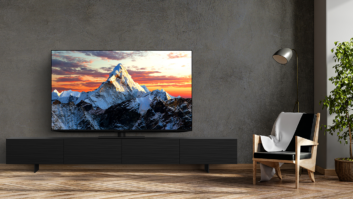In wide ranging discussions held here earlier this month Sharp executives reinforced the company’s plan to have an LCD-only TV lineup by 2005 in Japan, utilize its 1-bit technology in all Sharp audio products and enter the rewritable DVD market in the United States next year.
Sharp’s intention is to focus on product areas where it can be an industry leader, a strategy introduced by company president Katsuhiko Machida.
“I decided when I took over as president in 1998 not to compete on scale, but instead concentrate on products,” he said, adding that despite being one of the 20 largest companies in the world, it cannot compete with the top corporations across a broad product front.
The impact of these decisions can be seen in a preview of the company’s 2003 product road map and the company’s all-encompassing effort to dominate the LCD market. The product introductions will include the addition of two 37-inch LCD TVs to its Aquos line next year, a DVD-R/RW/RAM player and expanding Sharp’s 1-bit technology throughout its audio line.
The Aquos High Vision LC-37BT5 and LC-37BD5 launch in Japan in November, but are expected to hit the U.S. market in March 2003. Suggested retail prices in Japan are about $8,100 for the LC-37BT5 and $7,000 for the LC-37BD5. U.S. pricing has not been set. The LC-37BT5 comes with a 1-bit audio-based 150-watt home theater speaker package, while the latter is equipped as a standard TV.
The phase-out of CRT TVs is expected to be complete in three years for the Japanese market, and while Sharp has not set a date for when this will happen in North America, Machida does not expect it to happen before 2010. To meet this goal Sharp broke ground on a new LCD panel factory in Kameyama in September. It is expected to go online by May 2004 and exclusively produce 25-inch and larger LCD panels. These will be optimized for TV viewing and not as computer monitors, which is now the norm.
The plant will produce much larger mother glass, 1,500mm by 1,800mm, with a 90 percent or higher yield. Capacity will be about 15,000 sheets of glass per month, which is equal to 100,000 30-inch panels. This will equal about half of all large screen production worldwide, said Masaya Hijikigawa, general manager, display technology group.
These panels will incorporate Sharp’s new System LCD technology that allows a great deal of the TV circuitry to be placed on the panel itself and not in an outside component. Other improvements include the addition of an SD flash memory card slot on certain models now only found in Japan. These allow programming to be stored for viewing on other devices, including a new portable video player that also has built in MPEG-4 video recording capability. It is now selling in the Japanese market for about $350, but Sharp has no immediate plan to export it outside the country.
Machida hopes these product and facility additions will make Sharp the world leader in LCD. By the end of 2002 he hopes the company will be selling 20,000 LCD TVs per month in the U.S. market with 650,000 per year selling by 2005. He added that Sharp will not compete in the U.S. simply on price, but will concentrate on bringing high-quality devices in at a reasonable price. A strategy he hopes will give his company an edge on competitors like LG Electronics and Samsung.
Sharp is planning to have its entire audio products line in 1-bit by 2005, said Toshigure Hamano, general manager of Sharp’s A/V systems group. The breadth of Sharp’s 1-bit plans can be seen in its upcoming products. The company has introduced a 1-bit audio equipped portable MiniDisc player into the Japanese market and will follow this with the SD-AT100 and SD-AT50AV home theater receivers in the coming months.
In other product areas Sharp is pressing ahead with a Linux/Java OS-based Zaurus PDA and has high hopes of expanding the presence of its notebook computer line in the U.S.
“I think the OS for the PDA in the 21st Century must be open. I think some corporate and government buyers might not want to use an OS from a single source and I am convinced more applications will be developed for it [Linux/Java],” said Dr. Yoichi Sakia, general manager of Sharp’s communications group.
Buheita Fujiwara, Sharp’s general manager for international business, admitted increasing the company’s U.S. notebook sales will be difficult.
“We want to expand, but it will be very hard because of price considerations. Other companies are much less expensive, but we have hope.” The U.S. corporate market might be one area Sharp should explore to meet its goal, Fujiwara said.
The specifications on Sharp’s DVD-R/-RW/RAM device were not available, but Fujiwara said a working model would be shown in January at International CES and a product launch would follow in 2003.













